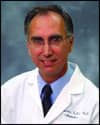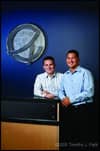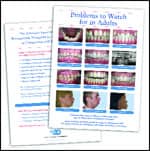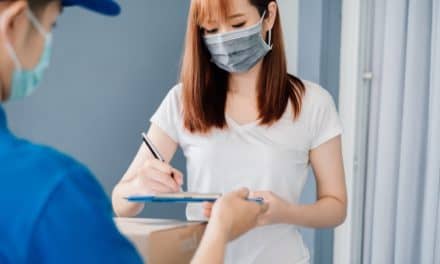| Orthodontists Should Be Aware of Back Strain |
|
The subjects of the study were videotaped performing their regular duties, and the recorded postures were analyzed frame by frame for top-to-bottom compression load, side-to-side shearing load, and exposure time. After reviewing the records from private clinics, researchers found that orthodontists treat an average of 70 patients per day with the help of assistants. Their body stress was induced by long periods of sitting (about 70% of their workday), with 90% of the strain coming from applying, removing, or adjusting braces. Shrawan Kumar, PhD, MSc, a professor of physical therapy at the University of Alberta, says that orthodontists should not ignore musculoskeletal disorders of the back and neck just because their daily tasks don’t involve heavy lifting. “Although the tasks appear to be light and harmless, by virtue of the frequency and duration of their performance, they are rendered hazardous.” |
| Researchers Hope Hormone Will Cut Treatment Time in Half |
|
“Most of orthodontics has traditionally dealt with physics, the biomechanics of applying a force against a tooth to move it,” says Timothy Wheeler, DMD, PhD, study investigator, and professor and chairman of orthodontics at the University of Florida’s college of dentistry. “Ours is the first study to use a naturally occurring hormone, recombinant human relaxin, to biochemically augment tooth movement and retention.” Relaxin, best known as the hormone that helps women’s pelvic ligaments stretch in preparation for childbirth, has the ability to soften collagen and elastin in the tissues, loosening strong, cord-like fibers. Thus, researchers are considering it as a possible way to accelerate tooth movement and prevent relapse after braces have been removed. The study will include 40 subjects who receive relaxin and a placebo. One tooth in each subject will be targeted for movement, and the subject will wear plastic aligners for 8 weeks to move the targeted tooth. After the eighth week, the aligners will be removed and the tooth will be evaluated for relapse every 4 weeks for 6 months. “If the results of the study demonstrate enhancement of the rate of orthodontic tooth movement and better stability after treatment, it could be an exciting new method of increasing treatment acceptability while decreasing the need for compliance,” says Robert Boyd, DDS, a professor and chairman of orthodontics at the University of the Pacific School of Dentistry, San Francisco. “Finishing orthodontic treatment without the usual regimen of lifetime use of retainers would greatly enhance the effectiveness and efficiency of current orthodontic treatment.” All 40 subjects will have completed the protocol by early October. |
| Center for Enhanced Training Offers CE and More |
|
“The goal is to offer a facility especially for continuing education and to bring a comprehensive series of clinics, scholars, and training programs to dental professionals in the Northwest,” says Keith Holm, cofounder and CEO of CET. “We’re here to help the entire dental office do more than earn the required CE credits. We’ll keep them on top of the rapidly changing industry and technology that’s available.” The privately funded, 15,000-square-foot dental training center and multi-purpose facility is equipped with instruments, laser technology, digital x-ray equipment, dental imaging scopes, a crown-milling machine, a training lab, audiovisual equipment to record and reproduce lectures, and a 140-seat stadium-style auditorium. CET aims to offer a year-round roster of courses and lectures based on what’s taught in dental school, with an emphasis on practice management, treatment strategies, and patient care. CET will not be associated with a particular dentist, sponsor, or philosophy, and will be open to any and all programs, speakers, and study clubs. |
| Industry-Wide Study Ranks Search Engine Marketing |
|
To measure the rankings of orthodontic Web sites in more than 40 geographic markets across the United States and Canada, the study used WebPosition® from WebTrends Inc to analyze results on 18 leading search engines. According to Bob Garcia, director of the WebPosition business at WebTrends, “Sesame Communications sets a great example for organizations wanting to optimize their online business through search-engine marketing.” |
| New Marketing Web Site Goes Online |
|
|
| AAO Offers New Orthodontic Evaluation Guides |
|
Problems to Watch for in Adults features photographs of 12 different malocclusions in adults and outlines several reasons why correction of orthodontic problems is important. Problems to Watch for in Seven-Year-Olds and Problems to Watch for in Growing Children are now available in English or Spanish. Both guides feature photographs of nine different malocclusions that may benefit from early diagnosis and referrals to orthodontic specialists. For additional information or to order any of the guides, contact the AAO’s order department at (800) 424-2841 or visit www.aaomembers.org. |
| ABO to Hold Certification Conference |
|
The American Board of Orthodontics (ABO) will hold a 1-day Educators Conference on October 8, 2005, at the St Louis Airport Marriott. The goal of the conference is to give educators practical suggestions to facilitate orthodontic resident certification. The ABO will invite two faculty members from each program, and invitations may be expanded if space is available. The conference will explore the new certification process, which it announced this past March. Topics of discussion will include early certification, the Gateway Offer, and recertification. ABO directors will also delve into the Phase II Written Examination and the Phase III Clinical Examination, along with the ABO’s Pilot Study and new testing instruments. For additional information, visit www.americanboardortho.com. |
Newsbites

Newsbites

 A study of graduate orthodontic students and practicing orthodontists, conducted at the University of Alberta, Canada, has found that long hours of bending to work in patients’ mouths puts a strain on the lower back and neck. In the study, a day’s work for the male orthodontists was the equivalent of carrying 450 kg for 1 hour; female orthodontists’ load was 275 kg. Male orthodontists bore heavier loads than their female counterparts because of their heavier body weights.
A study of graduate orthodontic students and practicing orthodontists, conducted at the University of Alberta, Canada, has found that long hours of bending to work in patients’ mouths puts a strain on the lower back and neck. In the study, a day’s work for the male orthodontists was the equivalent of carrying 450 kg for 1 hour; female orthodontists’ load was 275 kg. Male orthodontists bore heavier loads than their female counterparts because of their heavier body weights.  University of Florida researchers are currently testing the possibility of the natural hormone relaxin to biochemically help move teeth faster and less painfully during orthodontic treatment. Researchers hope the drug will cut orthodontic treatment time in half and eliminate the need for retainers after braces have been removed.
University of Florida researchers are currently testing the possibility of the natural hormone relaxin to biochemically help move teeth faster and less painfully during orthodontic treatment. Researchers hope the drug will cut orthodontic treatment time in half and eliminate the need for retainers after braces have been removed.  The Center for Enhanced Training (CET), a $2-million high-tech clinical and conference center, has opened its doors to the professional dental community by offering continuing education (CE) and training for dental professionals.
The Center for Enhanced Training (CET), a $2-million high-tech clinical and conference center, has opened its doors to the professional dental community by offering continuing education (CE) and training for dental professionals.  Sesame Communications has unveiled the results of the first industry-wide search-engine marketing study to gauge visibility for American and Canadian orthodontists’ Web sites on the Internet’s leading search engines. The findings conclude that Web sites hosted by Sesame Communications consistently rank higher in natural search visibility than leading industry competitors and are more visible to consumers searching for orthodontists. According to the study, Web sites hosted by Sesame had the highest natural Visibility Percentage, meaning they had the most top-ranked, number-one positions.
Sesame Communications has unveiled the results of the first industry-wide search-engine marketing study to gauge visibility for American and Canadian orthodontists’ Web sites on the Internet’s leading search engines. The findings conclude that Web sites hosted by Sesame Communications consistently rank higher in natural search visibility than leading industry competitors and are more visible to consumers searching for orthodontists. According to the study, Web sites hosted by Sesame had the highest natural Visibility Percentage, meaning they had the most top-ranked, number-one positions.  Anew informational Web site,
Anew informational Web site,  The AAO recently augmented its collection of orthodontic evaluation guides by introducing a guide to adult orthodontic problems and translating the guide to orthodontic problems in children into Spanish.
The AAO recently augmented its collection of orthodontic evaluation guides by introducing a guide to adult orthodontic problems and translating the guide to orthodontic problems in children into Spanish. 






